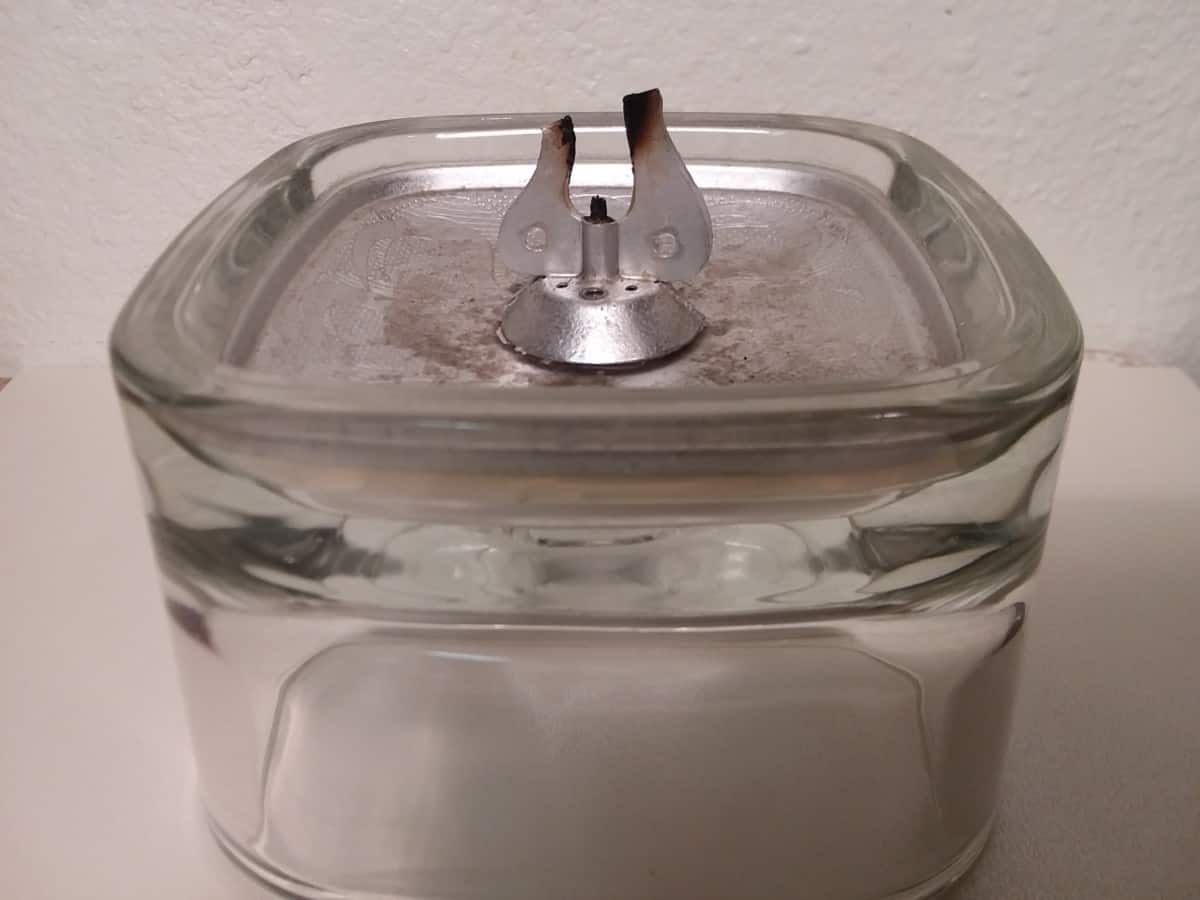I’ve seen people asking if candles burn out on their own, so I thought I would do some research to find the answer. What I discovered is that the consensus is to never leave a candle to burn itself out. However, this does not actually answer the question, so I decided to do my own research and experiment to find out if candles actually burn themselves out.
Do candles burn themselves out? Never leave a candle unattended! However, if you happen to leave a candle burning, it will burn itself out if it has a wick with a metal “neck” or bottom. These types of wicks are most commonly found in container candles. You should never let a candle burn itself out! Allowing a candle to burn to the very bottom could cause the container to break and the wick to fall out! And if the wick falls onto a flammable surface, you will have a fire in a quick minute!
I think we all know not to leave a burning candle unattended. It is posted on the warning labels of every candle we buy. However, sometimes things happen. We forget that we lit a candle and leave it burning when we go run errands. Here are some other things to consider when leaving a candle burning.
Leaving a Candle Burning
A candle that will burn itself out will have a self-extinguishing wick, such as a metal tab with a “neck.” However, unless you have made the candle yourself and know which wick you used, you may not be certain if your candle flame will self-terminate. If you purchased your candle in a store, you are basically taking a gamble if you leave your candle to burn itself out.
A glass jar candle is especially risky to burn to the bottom, because allowing the heat to reach the bottom of the container could cause it to crack or explode, in which case the wax will melt out or the wick (flame) could fall out and cause a fire!
That is why it is also important to consider the surface on which you are burning your candle. Along with never leaving a candle unattended, the second most important warning is to always burn your candle on a heat-resistant surface.
I wrote an article explaining the different types of heat-resistant surfaces that are safe to burn a candle on if you want to check it out.
Heat-resistant surfaces are those that do not burn easily or heat up quickly and are made to withstand warm temperatures. Good examples of heat-resistant surfaces that would be good to burn candles on include stovetops; kitchen countertops, such as granite; dining room tables, specifically with treated wood; and other tables, chairs, or shelves with fire-resistant, treated wooden surfaces.
It may be surprising to hear that wood is heat-resistant. Many dining room tables, living room furniture (side tables, coffee tables, etc.), and bedroom furniture (night stands, dressers, etc.) are made of fire-resistant, treated wood.
You can also buy candle holders or plates, which are usually made of glass or metal that is heat-resistant. These provide a safe surface to burn your candle, even if you are not sure the table or surface you are setting the candle holder on is heat-resistant. These can be found in the home décor section of any department store.
Do not burn candles around anything that is flammable or can catch fire, such as curtains, bed sheets, bedspreads, blankets, pillows, or cushions. It is also important to avoid placing your candle in drafty areas, such as near an open window or close to vents. The wind or air circulation could cause the flame to flicker or “jump,” which can start a fire quickly before you realize it.
Lastly, make sure you are placing your candle on a stable surface. Do not put your candle on an unstable chair, stool, or other object that could tip over. If your candle could be easily knocked or bumped over, it is unsafe. Make sure that your candle is on a steady, even surface.
What to Do If You Realize You Left a Candle Burning
First of all, if you are able, get back to the candle ASAP. For the purposes of this article and to simplify things, I am assuming you left the candle burning at home. So, all of my explanations and suggestions are based on the scenario of the candle burning unattended in your locked house with no one else at home.
If you are not able to get home in a timely fashion, you’re going to want to call someone (a friend, neighbor, or family member) who may be closer to your residence than you are at the moment and who would be able to arrive in a shorter amount of time than you. Hopefully this friend would be able to get into your house to check on the candle.
If they do not have access to your house, hopefully they can peek in the window of the room where the candle was left burning to make sure it is still contained. If they cannot visually see the candle and if they are willing, they could baby-sit your house for a few hours, or until you arrive home, to watch for smoke and make sure your house doesn’t start on fire. However, you will probably need a very close friend or neighbor that would be willing to do that.
Another option is that they climb through a window (if able) to get inside your house, but someone may witness this and think they are breaking into your house! Then, you will get the police there in a hot minute!
Otherwise, you are going to have to call the police or fire department and ask them to check on your house. But again, if they can’t see the candle from outside your home, there’s nothing much they can do from outside, but watch, unless you are okay with them breaking down your door or smashing a window to get into your house. And you can’t exactly ask or expect the police or fire department to sit and watch your home for hours. They have much more important things to be doing!
The best option is to find someone, anyone (neighbor, co-worker, family member, friend), who could stop by your house to check on it. You may have to consider allowing them to “break into your house.”
If you are willing to pay a locksmith, you could have the locksmith meet your friend or neighbor at your house, but I’m not sure how feasible that would be. The locksmith may not be willing to go along with this, if they are uncertain you are the true homeowner.
To learn from this, in the future, it is best to have a spare key somewhere secure, but accessible. You could hide it on your property somewhere or give a spare key to a trusted neighbor, friend, or family member to avoid this problem in the future…or to be prepared for it, if it were to happen.
What Happens When a Candle Burns Out on Its Own?
A burning candle requires a variety of different components, from the wick, to the wax, to the fire or flame that ignites it. In order to keep burning, a candle needs a wick that will keep the flame alive. When the flame gets to the bottom of the container or candle wax, it will continue to burn as long as it has a fuel source, which is either the wax, wick, or other flammable material.
In my “Safe Surfaces to Burn Candles On” post, I explain the “Fire Triangle,” which consists of the 3 components required to maintain a fire: fuel, oxygen, and ignition source.
Container candles usually have a self-extinguishing wick or metal-bottomed wick. However, this is not a guarantee.
With a pillar or taper candle, they usually don’t have a self-extinguishing wick or metal-bottom. The wick material, usually cotton, runs the entire length of the candle and does not have a “bottom piece,” like container candles do. This is because of how pillar and taper candles are made.
I did my own experiment to determine if a candle would burn itself out. Of course, I carefully monitored it the entire time. I used a small, wax melt type of candle with a metal attachment in a glass container. As the candle melted it created a pool of wax within this glass bowl. I believe this product was an old-school product from Glade. I know that I had it for a few years. It was a “magnetic” scented oil candle with a glass container for the wax to melt and create a pool. This product is no longer sold by the company.
I lit the candle, allowed it to melt into a pool of wax, and found that the candle did extinguish itself. Of course, I know this was because it had a metal stem/core for the wick. The base/bottom of the glass bowl/container was also metal and fire-resistant.
For most candles within a container, such as glass jar candles or tealights, and with a metal wick, the candle will burn itself out. However, any other candles, especially free-standing candles, such as pillars and tapers, there is not a bottom piece to the wick, so the candle would most likely NOT burn itself out.
I would be very concerned about the safety of a pillar or taper candle, if it was left to burn itself out.
Related Question
Can candles start house fires? Candles can start fires. However, if you educate yourself on the facts and take a few simple safety precautions you can prevent a candle house fire. If you would like more information, please read my article on “Candles and House Fires.”



